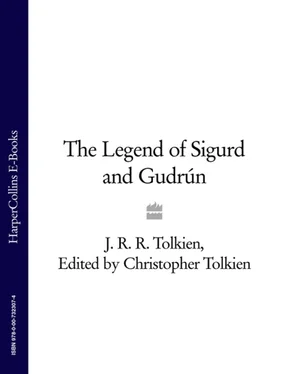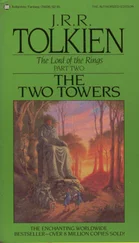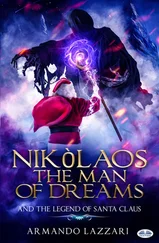J. Tolkien - The Legend of Sigurd and Gudrún
Здесь есть возможность читать онлайн «J. Tolkien - The Legend of Sigurd and Gudrún» — ознакомительный отрывок электронной книги совершенно бесплатно, а после прочтения отрывка купить полную версию. В некоторых случаях можно слушать аудио, скачать через торрент в формате fb2 и присутствует краткое содержание. Жанр: Старинная литература, на английском языке. Описание произведения, (предисловие) а так же отзывы посетителей доступны на портале библиотеки ЛибКат.
- Название:The Legend of Sigurd and Gudrún
- Автор:
- Жанр:
- Год:неизвестен
- ISBN:нет данных
- Рейтинг книги:5 / 5. Голосов: 1
-
Избранное:Добавить в избранное
- Отзывы:
-
Ваша оценка:
- 100
- 1
- 2
- 3
- 4
- 5
The Legend of Sigurd and Gudrún: краткое содержание, описание и аннотация
Предлагаем к чтению аннотацию, описание, краткое содержание или предисловие (зависит от того, что написал сам автор книги «The Legend of Sigurd and Gudrún»). Если вы не нашли необходимую информацию о книге — напишите в комментариях, мы постараемся отыскать её.
The Legend of Sigurd and Gudrún — читать онлайн ознакомительный отрывок
Ниже представлен текст книги, разбитый по страницам. Система сохранения места последней прочитанной страницы, позволяет с удобством читать онлайн бесплатно книгу «The Legend of Sigurd and Gudrún», без необходимости каждый раз заново искать на чём Вы остановились. Поставьте закладку, и сможете в любой момент перейти на страницу, на которой закончили чтение.
Интервал:
Закладка:
A widely held but by no means unchallenged theory rests upon the interpretation of the name Nibelung (Niflung) as etymologically related to a group of Germanic words meaning ‘darkness’ or ‘mist’ (modern German retains the word Nebel ‘mist’). This is brought into connection with certain things said about the Nibelungs. Snorri Sturluson said of the grandsons of King Gjúki that they were ‘black as a raven in the colour of their hair, like Gunnar and Högni and the other Niflungar’; and in a much earlier (ninth century) poem they are called hrafnbláir ‘raven-black’: in the Lay of the Völsungs (VII.10) it is said: ‘As ravens dark were those raven-friends’.
An essential element in this theory is the figure of Högni, as he appears in German tradition. In the Nibelungenlied his name is Hagen, and he is not the brother of the Burgundians but their kinsman and vassal. Ferocious and cruel, hating Siegfried and indeed his murderer, he is very unlike the Norse Högni. In the Thiðrekssaga, a large compilation made in Norway, in Bergen, about the middle of the 13th century, but based on stories then current in North Germany, Högni, as he is named in this work, is the half-brother of the Burgundians, for a fairy or incubus slept with his mother, and the offspring of the union was Högni. In the Thiðrekssaga his appearance is troll-like, and he is said to have been all over dark, with black hair and black beard. Especially notable is the fact that the name Hagen/ Högni does not alliterate on G, showing that he did not originally belong to the Burgundian clan at all.
An important evidence appears at the beginning of the Nibelungenlied. When Siegfried arrived at the Burgundian court at Worms Hagen looked down from a window at the magnificent knight who had ridden in with a fine company; and guessing who it was he told King Gunther a story concerning a great exploit of Sigurd. With the air of a casual insertion, Hagen’s story is briefly reported in the poem in a very obscure fashion, and I will refer here only to features essential for this purpose.
Siegfried was one day riding alone past a mountain, and he came upon many men gathered round a huge treasure which they had carried out of a cavern. For reasons that are not clearly explained Siegfried came into conflict with ‘the bold Nibelungs’, the two princes named Nibelung and Schilbung, and slew them, and their friends. He fought also with a dwarf named Alberich, and subdued him, but did not kill him: he had the hoard taken back into the cavern whence it had come, and made Alberich the guardian of the treasure. He was now the lord of ‘Nibelungeland’, the possessor of the great hoard, and for the rest of the first part of the Nibelungenlied he has the support of warriors from Nibelungeland, who are called Nibelungs. But in the second part of the German poem, which is held to rest on a quite different poetic source, the name ‘Nibelungs’ is applied, very strangely and on a first reading of the poem most disturbingly, in a totally different sense: it now means the Burgundians, just as it does in Norse.
Hagen also knew, and told this to Gunther, that Siegfried had slain a dragon and bathed in its blood, from which his skin grew so horny that no weapon would bite it. But this is in no way associated with the Nibelung hoard.
In the Nibelungenlied the hoard is associated with a dwarf, and a cavern in a mountain. What is the significance of the Dwarves?
In Norse mythology we are confronted, in the mythological poems of the Edda and also in Snorri Sturluson’s treatise, with a great many scattered hints and observations about the minor beings of the immensely rich and many-peopled heathen supernatural world. Taken all together it is baffling; and beyond question there was once a whole world of thought and belief concerning these beings which is now almost totally lost. However, bearing in mind that Snorri was writing in the thirteenth century and that behind him stretch century upon century of unrecorded, various and shifting beliefs, we may notice what he says: which is, that there are the Light Elves, Ljósálfar , and the Dark Elves, Dökkálfar . The Light Elves dwell in a glorious place called Álfheimr (Elf-home, Elf-world), but the Dark Elves ‘live down in the earth, and they are unlike the Light Elves in appearance, but much more unlike in nature. The Light Elves are fairer to look upon than the sun, but the Dark Elves are blacker than pitch.’
So far as we can now tell, there seems little difference between the Scandinavian Dark Elves, black as pitch and living underground, and the Dvergar , Dwarves; in fact Snorri more than once refers to Dwarves as inhabitants of Svartálfaheimr , the Land of the Dark Elves. The Dwarf Andvari, original owner of Fáfnir’s treasure, dwelt, according to Snorri, in the Land of the Dark Elves (see the commentary on the Lay of the Völsungs, p.189): there he kept his hoard within a rock, and there Loki caught him.
Characteristics of the Dwarves in Old Norse literature may be briefly mentioned. They are above all master-craftsmen, the makers of marvellous treasures and wonderful weapons. The most renowned objects in the Norse myths were made by Dwarves: Ódin’s spear Gungnir, Thór’s hammer Mjöllnir, and Skíðblaðnir, the ship of the God Freyr, which could carry all the Gods, yet was made so intricately that it could be folded up like a napkin and put in a pouch.
Dwarves lived always underground or inside rocks (an echo was called dverg-mál, ‘dwarf-talk’); and they possessed vast knowledge. If caught in the open after sunrise they were turned to stone. There is a poem in the Edda, the Alvíssmál, in which the God Thór asks many questions of a Dwarf named Allvíss (‘All-wise’); and Thór kept him answering his questions so long that the sun came up. The poem ends with Thór crying: ‘Dwarf, you are uppi dagaðr ’, you are ‘dayed up’, the sun has caught you.
The train of thought that emerges from all this will be clear, and the conclusion. Dark Elves, black as pitch, and Dwarves, closely related in Norse mythology if not identical, guardians of treasure in caverns and rocks; Alberich and Andvari; the origin of the Nibelung name in connection with ‘darkness’ words; Hagen’s ‘elvish’ birth, his dark and troll-like appearance in Thiðrekssaga. On this theory, this is what the Nibelungs originally were: they were beings of darkness, Dark Elves or Dwarves, and Siegfried/Sigurd stole their great treasure from them.
This ‘mythological’ theory, or some form of it, is radically challenged by other scholars. From place-names and personal names in the region of Burgundian settlement there is evidence that is interpreted to mean that Nibelung was the name of a powerful Burgundian family or clan. Putting the matter in its simplest form, it is supposed on this basis that the (purely human) Nibelung clan of Burgundia either possessed very great wealth in historical fact, or else very early had it attributed to them; and ‘the hoard of the Nibelungs’ was the family treasure of the Burgundian kings.
That my father subscribed to the ‘mythological’ theory in some form is plain; but his view of the process by which the Burgundians became Nibelungs is nowhere clearly or fully expressed in his writings. He had suggested (see this Appendix p.341) that the connection of the ‘Dragon-hero’ with the Burgundian king Gundahari began with ‘gold’ as a motive to explain Attila’s attack (when Attila had become the leader of the Huns in the destruction of the Burgundian kingdom of Worms). As Gundahari faded back into the past (he wrote), old legends of fairy-hoards localized on the Rhine naturally became attached to the famous king in Worms: ‘this treasure probably had demon or dwarvish guardians already, but need not originally have been the same as Sigemund’s gold, though it may well have been.’
Читать дальшеИнтервал:
Закладка:
Похожие книги на «The Legend of Sigurd and Gudrún»
Представляем Вашему вниманию похожие книги на «The Legend of Sigurd and Gudrún» списком для выбора. Мы отобрали схожую по названию и смыслу литературу в надежде предоставить читателям больше вариантов отыскать новые, интересные, ещё непрочитанные произведения.
Обсуждение, отзывы о книге «The Legend of Sigurd and Gudrún» и просто собственные мнения читателей. Оставьте ваши комментарии, напишите, что Вы думаете о произведении, его смысле или главных героях. Укажите что конкретно понравилось, а что нет, и почему Вы так считаете.












